TABLE OF CONTENTS |
Part
I
Dedicating the Temple
The Church Concept of God
|
Part
III
(3) The Man with the Writer's Inkhorn
—The Second Assignment
(4) The Dedication of Ezekiel's Temple
|
Part
II
(1) The Dedication of the
Tabernacle
—-Bringing Home the Ark
(2) Solomon's Temple
—Dedicating the Temple
before It Was Finished |
Part
IV
(5) God's True Temple
—"Filled with Smoke from
the Glory of
God"
—What Happens Next?
—What Does the Dedication
of the True
Temple Portend?
—Why Is the Dedication
of God's Temple Important?
|
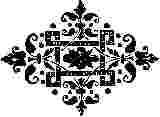
Part III
(3) The Man With the Writer's
Inkhorn
|

|
We wish to continue our comparative study. So often brethren will tell only half the story
of the man with the writer’s inkhorn and leave the most majestic part unsaid. Our
study forces us to address the rest of the story because it has to do with the glory of
the Lord filling the Temple. In Ezekiel 9:2-4:
|
"Six men came from the way of the higher gate, which lieth toward the north,
and every man a slaughter weapon in his hand; and one man among them was clothed with
linen, with a writer’s inkhorn by his side: and they went in, and stood beside the
brazen altar.
"And the glory of the God of Israel was gone up from the cherub, whereupon he
was, to the threshold of the house. And he called to the man clothed with linen, which had
the writer’s inkhorn by his side;
"And the Lord said unto him, Go through the midst of the city, through the
midst of Jerusalem, and set a mark upon the foreheads of the men that sigh and that cry
for all the abominations that be done in the midst thereof."
We understand this represents the work of
Harvest
wherein the Harvest Message is used to mark those who are out of harmony with antitypical
Jerusalem in its sinful state. That message has gone forth and as long as the
Harvest writings are going forth, the work remains unfinished.
The Lord is marking those who are not in sympathy with the sins
of Christendom, and who sigh and cry as they look within the systems. Such are
marked in the forehead and will be spared the faith destroying work that follows the man
with the writer's inkhorn.
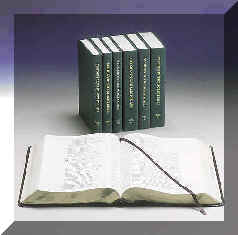 |
The man with the inkhorn we believe to be Bro. Russell, but the "inkhorn"
represents his writings and the truths he made known that are still reaching people, one
here and one there who are not in harmony with the sins of antitypical Jerusalem,
Christendom.
|
Contemporaneously, six men with slaughter weapons follow the man
with the "inkhorn." Their task was to slaughter those not having the mark in the
foreheads.
This pictures a faith-destroying work beginning in the sanctuary and
ultimately reaching the inhabitants of Jerusalem. We see how higher criticism, Christian
Science, Theosophy, Spiritism, Evolution, New Age, and
some types of psychology are being
used as slaughter weapons in Christendom, destroying faith in the blood of Christ.
When this work of marking is completed by the writer's inkhorn, then
the man reports, "I have done as thou hast commanded me." (Ezekiel 9:11) Some
apply this at Bro. Russell’s death, whereas this can only apply when the work of his
"inkhorn" has accomplished its intended purpose. His "inkhorn" is
still marking. It marked you and me, and one here and one there. When that work is done,
then what?

The Second Assignment
to the Man with the Writer's Inkhorn
The story does not stop at the close of Ezekiel 9. That is only half
of the story. In Ezekiel 10:2-4 we read about the other half:
"And he spake unto the man clothed with linen, and said, Go in between the
wheels, even under the cherub, and fill thine hand with coals of fire from between the
cherubims, and scatter them over the city. And he went in my sight.
"Now the cherubims stood on the right side of the house, when the man went in;
and the cloud filled the inner court.
"Then the glory of the Lord went up from the cherub, and stood over the
threshold of the house; and the house was filled with the cloud, and the court was full of
the brightness of the Lord’s glory."
Here we see the second commission given to the man
with the writer’s inkhorn. Please notice that it is only the seventh messenger, Bro.
Russell, who is assigned to "scatter"
"coals of fire" over the city of Jerusalem.
Just as the man in "linen" marked those that sighed and cried in the
city, so it is his writings that contain the
"coals of fire" for him to scatter over
the city. This would picture the second work of delivering the
"judgments of the Lord" against that city, which in antitype is Christendom.
In Ezekiel 10:7 we learn that one "cherub" reached in
and supplied the "coals of fire" to the man with the "inkhorn." These
four "cherubs" with their "wheels" pictured the four attributes of
God: power, love, justice and wisdom. It is apparently the cherub of justice that
initiates this activity.
The Harvest message will have this last function, but only after the
house of the Lord is "filled with the cloud" of the Lord’s glory. It is a
beautiful picture. More importantly, it is a detailed study involving the timing of
executing the judgments written. The work of marking those that sigh and cry does not go
on simultaneously with scattering coals of fire over the city. How readest thou? Read it
carefully, and you will see two separate works, the last work is one of judgment.
This was Bro. Russell’s thought. In Vol. 4, p. 18, we read:
"The treading of the winepress is the last feature of harvest. The reaping and
gathering is all done first." Somehow, the idea still persists that the
Harvest of
the true wheat and the treading of the winepress are contemporaneous works. Such was never
Bro. Russell’s view nor do the Scriptures present that scenario.

|
"Thrust in thy sickle, and
reap: for the time is come for thee to reap: for the harvest of the earth is ripe.
|
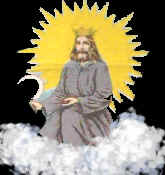
|
"And
he that sat on the cloud thrust in his sickle on the earth; and the earth was reaped.
"And another angel came out of the temple which is in heaven, he also
having a sharp sickle. |
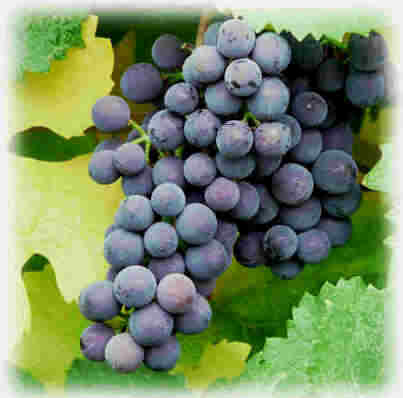
|
"And
another angel came out from the altar, which had power over fire; and cried with a loud
cry to him that had the sharp sickle, saying,
"Thrust in thy sharp sickle, and gather the clusters of the vine of
the earth; for her grapes are fully ripe."
Revelation 14:15-18 |
Here we see two separate works being described. "The treading
of the winepress is the last feature of Harvest."
(THE BATTLE OF ARMAGEDDON, p. 18) There is nothing to indicate that
the Harvest of the "true vine" and the final
Harvests of the "vine of the
earth" are contemporaneous. If the "vine of the earth" is already harvested
while we are still harvesting "wheat,"
it leads to confusion.
"The Parable of the Wheat and Tares" seems to teach a similar
lesson. Matthew 13:30 says:
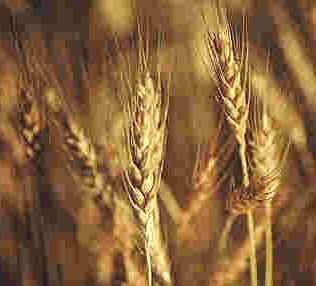
|
"Let
both grow together until
the harvest; and in the time of harvest I will say to the reapers, Gather ye together
first the tares, and bind them in bundles to burn them: but gather the wheat into my
barn."
|
While this verse does not show when the tares are
burned, it shows the two works of gathering and binding the tares into bundles and the
gathering of the wheat to be contemporaneous. However, the burning of the tares is never
simultaneous with the harvest. In wheat season when there is a lot of dry straw
everywhere, you make sure you have your wheat in the barn and your neighbor has his wheat
in the barn before you light any matches.
While it is true that many tares have ceased to be tares
throughout the Harvest because enamored with
Communism or some other enchanting
philosophy, we must know there are more tares today than in Bro. Russell’s time.
Estimates on the world Christian population varies between 15% to 30%.
In Reprint 5951, "The Harvest is not Ended," Bro. Russell
observes:
"The garnering of the wheat continues; but apparently the
consuming of the tares will correspond very closely with the division of Jordan. The tares
are a class of (often) noble people who have risen up out of the world infused with hopes
and aims of a benevolent character, but misled into thinking that they are the church.
"From the tare viewpoint, the wheat is an abnormal growth, a peculiar
people, few in number, and not held in high esteem. The smiting of the waters will reveal
the truth in respect to what is the real church of Christ, and what are imitations; and
the honest-minded tare class will be undeceived, and cease to longer pretend that they are
the church of Christ, thus they will be burned or cease to be as tares, continuing however
as noble-minded worldly people and will have a share in the general blessings of the
‘sweet by and by’ under the kingdom, for which we still pray."
Notice here, how Bro. Russell projects the thought that the
"tares" will learn the truth concerning the real
Church and thereby be
undeceived. Not only don’t the tares know who the true saints are, neither do we know
yet.

(4) The Dedication of
Ezekiel’s Temple
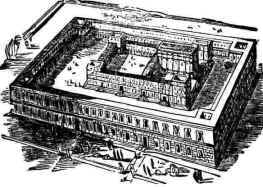
Ezekiel's Temple |
Ezekiel’s Temple was never really built. Just the same, it is pictured as being built
and therefore conveys lessons of great interest to the saints.
The East
Gate of Ezekiel’s
Temple is well known to the Arabs who
fear any construction by the Jews of anything near it.
It portends the thought that the Lord might enter through that
East Gate should it be built. So they are almost hysterical about any suggestion of an
East Gate. |
The only point we have time to consider is the fact that
Ezekiel’s Temple, though not actually built, was dedicated.
As a matter of fact, it was
dedicated twice. We read in Ezekiel 43:2-5:
"And, behold, the glory of the God of Israel came from the way of the east: and
his voice was like a noise of many waters: and the earth shined with his glory.
"And it was according to the appearance of the vision which I saw, even
according to the vision that I saw when I came to destroy the city: and the visions were
like the vision that I saw by the river Chebar; and I fell upon my face.
"And the glory of the Lord came into the house by the way of the gate whose
prospect is toward the east.
"So the spirit took me up, and brought me into the inner court; and, behold,
the glory of the Lord filled the house."
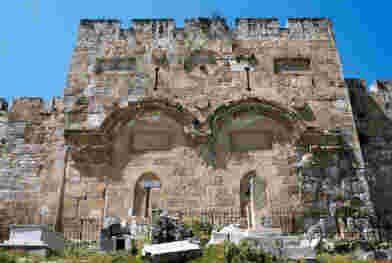
The Golden Gate
is the
Eastern Gate
of Jerusalem Today |
The time will come when the Lord shall enter His Temple and from the information at hand,
that may be while some saints are on this side of the veil.
The "east gate" represents the door to the high calling.
|
Just as the entrance of the
Tabernacle was on the
East Side, so here the Temple conveys the same thought. When that door is shut, and it is
the Lord that commands it to be shut (not any man or organization), none may enter into
the high calling forever. Then the Lord leaves by way of the "East
Gate."
Then the command was given in Ezekiel 44:2:
"Then said the Lord unto me; This gate shall be shut, it shall not be opened,
and no man shall enter in by it; because the Lord, the God of Israel, hath entered in by
it, therefore it shall be shut."
That gate closes forever, even as does the door to the high calling when the moment
spoken of occurs. However, then we read in Ezekiel 44:4:
"Then brought he me the way of the north gate before the house: and I looked,
and, behold, the glory of the Lord filled the house of the Lord: and I fell upon my
face."
We see here two recordings of the "glory" filling the
house, one when the Lord enters the "East
Gate" and the other when the
"North Gate" is entered. What might this mean? It is hard to know exactly. We
may only venture a guess.
Possibly, closing the "East
Gate" indicates the ending of the
"high calling" while some saints are still sealed and remain in the flesh, just
as Solomon’s Temple was dedicated before it was completed. The second filling with
"glory" occurs when the "North
Gate" is entered.
This may be the time
when all the saints are glorified with the Lord in the air. If you have a better thought, I
should be glad to hear it. We cannot help muse on this point because these verses are
trying to tell us something.
Some have thought the Lord may literally have some rare phenomena in
the heavens to mark the "filling of the house of God with glory" even as he had
the star guide the wise men from the east, only of greater splendor. Something glorious
may occur when this great moment in history and in all time occurs.
After all, that will mark the great moment when God will enter his
Temple, which Temple ye are. He planned for eternity for this event and when it happens it
seems logical that God would have some extravagant celebration.